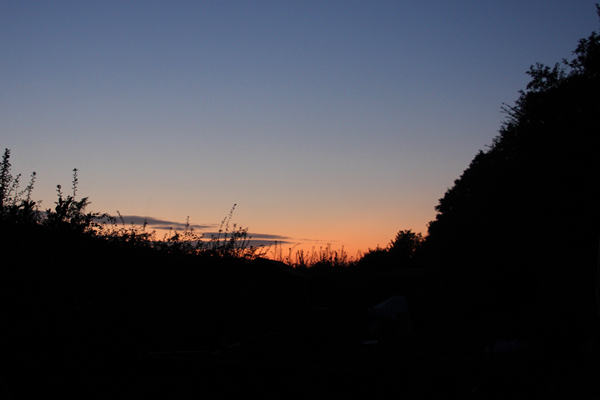The subtitle of this post should be ‘Wet, wet, wet’ as the dew last night was epic, I have never seen so much moisture when it isn’t actually raining. Everything was wet, the ground, the scope (by the end of the session the secondary looked like it had no coating on, it was so wet), the inside of the shed and the Telrad dew shield may as well have not been on there – the scope shroud was so wet it was dripping. The moisture got into everything. I think it was because we’re in a sudden warm spell, an Indian Summer, with daytime temps of around 75-80°F and nighttime lows of 63°F, but the ground is still wet after the dismal summer. It was misty but a threatening fog bank did stay out in the English Channel.

Clearest it's been for ages...
Date: 28th September 2011
Conditions: Cloudless but with some mist. 90% humidity resulting in a lot of dew. Light domes more apparent than usual.
Seeing: II (Good to fair)
Transparency: III (would have been good if not for the mist)
NELM: 6.0 to 6.1 at zenith
Equipment: 18 inch f/4.3 Dob, 22mm Televue Panoptic (90x), 8mm Panoptic Radian (247x)
Picking off galaxies with the 18 inch is like shooting fish in a barrel, it’s that easy, even under far-from-pristine conditions. I’ve gained a magnitude over the 12 inch and it’s so much easier to see fainter galaxies, of course.
I began with some galaxies in Pegasus.
NGC 7448 – Large, bright galaxy elongated north-south with brighter centre. 247x
NGC 7465 – Round with bright core surrounded by fuzzy halo. 247x
NGC 7463 – Elongated east-west. Fainter than 7465. Some slight brightening towards the centre. 247x
NGC 7464 is very close to 7463, faint. 247x
These galaxies were very faint indeed at 90x. Probably not helped by the dewy conditions.
NGC 7332 – Beautiful bright edge-on spiral elongated NNW-SSE. Very bright and obvious at low power (90x). Brightens to compact core and very bright almost stellar nucleus. 90x, 247x
NGC 7339 – Large and much fainter than NGC 7332. Featureless. Fairly blunt, rather than tapered, ends. 247x
NGC 7177 – Bright round galaxy. Fuzzy edges and a bright non-stellar nucleus. 247x
On to Pisces…
NGC 467 – One of an attractive line of galaxies. Diffuse halo brightens to a compact, but non-stellar, core (MAC 0119 + 0317, next to it, wasn’t seen). 247x
NGC 470 – Slightly larger than 467. Round with bright, compact core surrounded by a diffuse halo. 247x
NGC 474 – This is the same brightness as 470. Slightly oval and elongated WSW-ENE. Brightens to a bright, non-stellar, core. 247x
Then Andromeda…
NGC 214 – Fairly large and moderately bright. Elongated NE-SW. No nucleus. 247x
Eye candy:
Jupiter was excellent, very detailed and took magnification well in moments of good seeing. The four Galilean Moons were strung out either side, with two on each side. The SEB returned a while back and is nicely on show again.
M31, also in the eye candy department, was spectacular. I’d never seen it in anything larger than my 12 inch, and it was very bright and the dust lane was as prominent as ever I have seen it. I’m going to hunt for globular clusters in it one night, when the seeing is better. M32 and M110 were also very bright and prominent: M32 is the brighter and smaller of the two.
By now, the optics were so badly dewed up, it was becoming difficult to see anything so I packed up. I am going to invest in a dew heater once I have flogged off the 12 inch; actually I am going to invest in a dew heater even if I don’t manage to flog off the 12 inch! If the optics get dewed badly too often then a recoat will be necessary in a couple of years, something I’d prefer to avoid if possible. The Telrad, despite shield, was also badly dewed and made it nearly impossible to find anything.
I’d been using the stepladder a fair bit and, because the top lawn is undermined by generations of moles, one side of the ladder would occasionally sink into one of the tunnels. I never once fell off but it made life difficult and annoying. Not only that, the lawn has a very uneven surface but it is going to be hard to level it out and fill in all the mole holes.